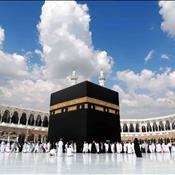The blessed month of Dhul Hijjah is fast approaching, and many of you will either have loved ones who will be making Hajj or are fortunate to go yourselves this year. The most pressing worry we have for this trip is obviously: will my Hajj be accepted? With that in mind, we’ve put together all the rules of Hajj (and ‘Umrah) into a simple guide to ensure you perform this spiritual obligation correctly.
Without further ado, let’s begin on how to perform Umrah.
Step One - Ihram
Ihram is a sacred state (of mind and body) into which a Muslim enters before performing Hajj or ‘Umrah. If you are flying into Makkah, your Ihram will begin on the plane at a location outside of Makkah, usually about an hour and a half before you enter Makkah. These locations where Ihram begins are known as Meeqats.
Procedures of Ihram
-
Preparing for Ihram:
-
Cleaning your body (removing hair, clipping nails, trimming the moustache, taking a shower) is recommended. This can be done before flying.
-
Wear your Ihram clothes, preferably after performing one of the five daily prayers.
-
Making Intention:
-
Make your intention to perform Hajj Tamattu’ and ‘Umrah.
-
Say Allahumma labbayka ‘Umrah (here is the Arabic du’a).
-
Recite the Talbiyah.
-
Rules for Ihram:
-
Do not fight or quarrel with others.
-
Do not curse, talk sinfully, or use any bad language.
-
Do not use perfume. This includes scented soaps, shampoos, wipes, lotions, etc.
-
Do not cut, pluck, or remove any hair or nails. (Broken nails can be removed).
-
Do not engage in any sexual activity.
-
Do not kill, hunt, or help others hunt any animals.
-
Do not marry, propose, or help others to marry.
To summarize: you have passed over the Meeqat, made the intention to begin your Hajj, and entered into a state of Ihram. The Ihram is a state of mind and, just like when you begin praying or fasting, certain things which would ordinarily be halal for you are now haram. It is important to maintain this state of mind as you proceed through the next steps.
Step Two - Tawaf
Tawaf is the ritual of circulating the Ka’bah seven times on Hajj and Umrah.
Before Beginning Tawaf:
-
Ensure Wudu: You must have wudu (ablution). Menstruating women cannot perform Tawaf.
-
Men’s Ihram: Men should wear their Ihrams so that their right shoulder is bare. This is known as Idtiba’a. Men need to cover their shoulders again after their Tawaf is complete (i.e., after seven tawafs).
How to Perform Tawaf:
-
Start at the Black Stone:
-
Recite the du’a at the Black Stone.
-
You may kiss the Black Stone, touch it and then kiss your hand, or point to it without kissing your hand.
-
Move from the Black Stone to the Yamaani Corner:
-
Do not touch any other part of the Ka’bah.
-
You may make any du’a you choose.
-
Once at the Yamaani corner, you can touch it if you are close enough, but don’t kiss it or kiss your hand.
-
Continue with your Tawaf, circling back towards the Black Stone while reciting the du’a of Tawaf.
-
Complete Seven Circuits:
-
Your first Tawaf ends where you began, at the Black Stone. Now continue into your second Tawaf and repeat the same steps.
-
You must circle the Ka’bah seven times for your whole Tawaf to be complete.
Notes:
-
Don’t go into the Hateem. If you do, that particular Tawaf doesn’t count, so you will have to repeat it.
-
For the first three tawafs, men should slowly jog (Ramal). Women must walk normally in all seven tawafs. Men should walk normally in the last four tawafs.
Step Three - After Tawaf
The Tawaf you are performing is known as Tawaf Al-Ifadah. To complete it, you must pray at Maqam Ibrahim and drink Zamzam water.
Maqam Ibrahim:
-
After Completing Tawaf:
-
Go towards Maqam Ibrahim reciting the ayah.
-
Stand so the Maqam Ibrahim is between you and the Ka’bah. Don’t try to stand directly in front of it – it will be far too crowded. Anywhere in Al-Masjid Al-Haram is fine, as long as the Maqam is between you and the Ka’bah.
-
Pray two rakats. It is recommended to recite Surah Kafiroon in the first rakat and Surah Ikhlas in the second rakat (after Surah Fatihah, of course).
Zamzam Water:
-
After Praying at Maqam Ibrahim:
-
Go to any Zamzam water point.
-
Drink Zamzam water while standing. Pouring the water over your head is also recommended.
-
Recite the du'a while drinking Zamzam.
-
Now you need to leave Al-Masjid Al-Haram for Sa’ee - so recite the du’a for leaving the masjid.
Step Four - Sa’ee
Sa’ee is the ritual of walking seven times between the hills of Safa and Marwah.
How to Perform Sa’ee:
-
Preparation:
-
It is recommended to have wudu, but it is not compulsory. Menstruating women should perform Sa’ee.
-
On your way to Sa’ee, you may recite the ayah about Safa and Marwah.
-
Begin at Safa:
-
You must make seven rounds between the hills of Safa and Marwah. Walking from Safa to Marwa is counted as one round, and Marwah to Safa as another round.
-
Men only must run part of the way. This area is clearly marked by green tubelights.
-
At the top of each hill, recite the du’a (similar to the Eid takbeer) three times. You can make personal du’as after this.
Completion:
-
Sa’ee is completed after seven rounds, ending at Marwah. You have now completed the first part of Hajj, which is the same as ‘Umrah. If you are performing Hajj Tamattu’ (this is what the majority of pilgrims perform), it is time to end your Ihram.
Step Five - Ending Ihram
How to End Ihram:
-
For men, this means trimming or shaving the hair on their head and changing from Ihram clothes to normal clothes.
-
For women, this means trimming their hair by a fingertip. Then the state of Ihram is ended, and the rules of Ihram are lifted.
If you were performing ‘Umrah, you have now completed it.
Summary of Part One:
-
Begin Ihram at the Meeqat.
-
Perform Tawaf.
-
Pray two rakat.
-
Drink Zamzam water.
-
Perform Sa’ee.
-
End your Ihram.
Note that menstruating women can’t do Tawaf or pray, but they can take part in other parts of the pilgrimage. You are now free to worship in Al-Masjid Al-Haram until the 8th of Dhul Hijjah.
We’ve put together a list of essential du’as to memorise for Hajj, so go check it out. Or go to Part Two of the Hajj guide to see the steps you must perform from the 8th of Dhul Hijjah onwards. You can also watch our Hajj documentary series, "The Prophetic Steps," filmed in Makkah, to learn more about the different steps of Hajj, including the history of the Ka'bah itself.

 26-Dec-2024Hiring of Services for Moavineen/ Nazims for Hajj 2025 Announced
26-Dec-2024Hiring of Services for Moavineen/ Nazims for Hajj 2025 Announced 04-Apr-2025Reopening of Embassy in Islamabad for Migration Matters
04-Apr-2025Reopening of Embassy in Islamabad for Migration Matters 25-Mar-2020VR Travel: A Novel way to Travel amid Coronavirus Consequences
25-Mar-2020VR Travel: A Novel way to Travel amid Coronavirus Consequences 24-Dec-2019The Rumors against Saudi Arabia Multiple Visa Has Declared By Embassy
24-Dec-2019The Rumors against Saudi Arabia Multiple Visa Has Declared By Embassy 04-Aug-2021ICA approval for UAE flights How residents can apply
04-Aug-2021ICA approval for UAE flights How residents can apply 18-Nov-2024Hajj Application 2025- New Government Scheme Announced- Key Date and Detail Revealed
18-Nov-2024Hajj Application 2025- New Government Scheme Announced- Key Date and Detail Revealed 21-May-2024Umrah Allowed To Hajj Permit Holders Only| Visa Holder can't enter Makkah during Hajj
21-May-2024Umrah Allowed To Hajj Permit Holders Only| Visa Holder can't enter Makkah during Hajj 27-May-2022Pakistan Government Announces Hajj Package 2022
27-May-2022Pakistan Government Announces Hajj Package 2022